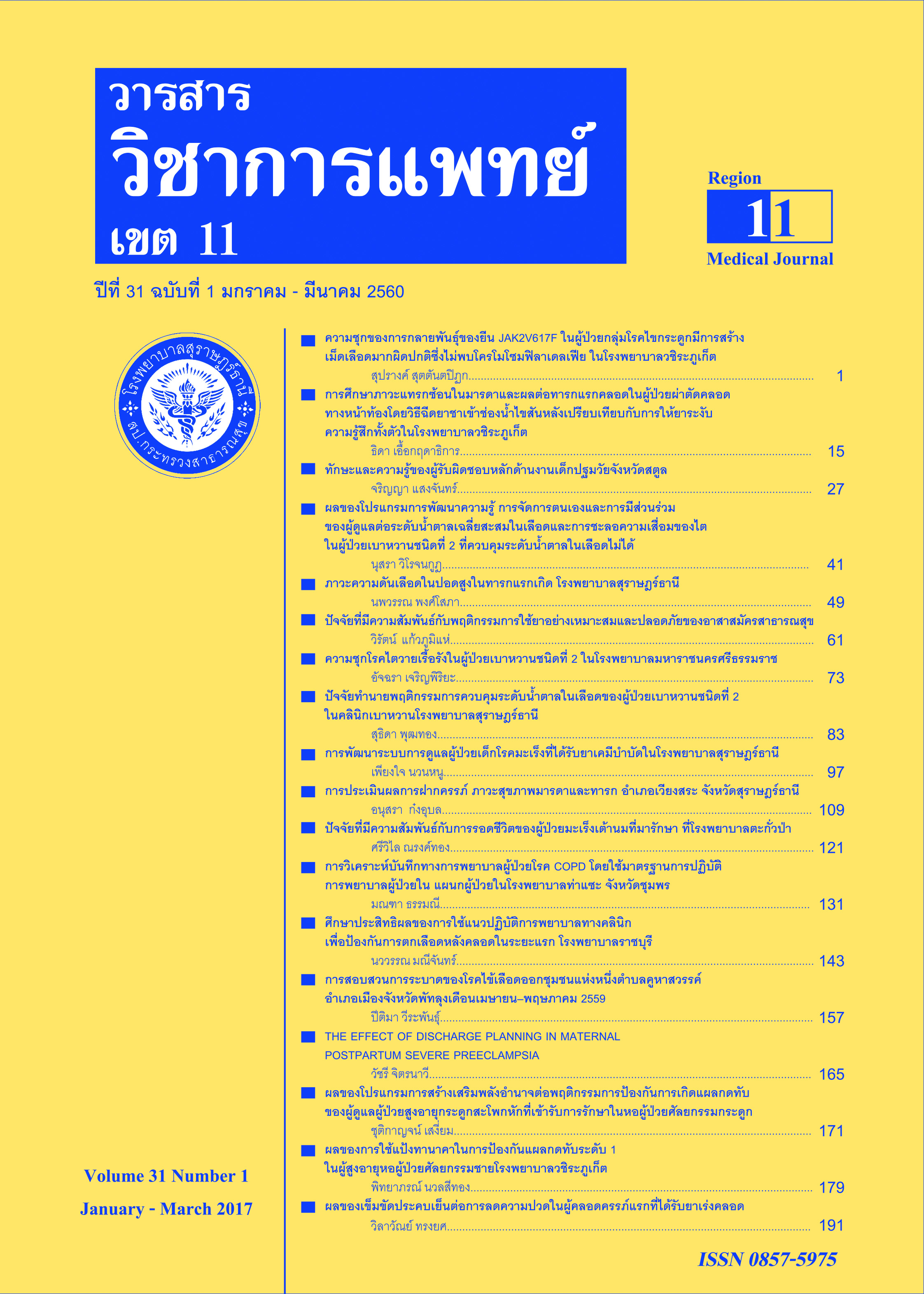THE EFFECT OF DISCHARGE PLANNING IN MATERNAL POSTPARTUM SEVERE PREECLAMPSIA
Keywords:
discharge planning, severe preeclampsia, self-careAbstract
This research aims to study comparison of knowledge on pretest-posttest discharge planning of maternal postpartum severe preeclampsia self-care and comparison of pretest-posttest discharge planning on eclampsia violence, Quasi Experimental Research Design by One Group pretest-posttest design. This was operated during May to August, 2016 by selected the specific sample with fit qualification about 10 people. 2 Collection tools are personal questionnaire and knowledge on maternal postpartum severe preeclampsia self-care as M-E-T-H-O-D Form around 20 issues. The Answer type is true and false calculated by internal consistent reliability coefficient KR 20 as .86. Research tool is applied discharge planning as M-E-T-H-O-D including 1) discharge
planning activity form by concept idea M-E-T-H-O-D, 2) personal hygiene teaching plan, 3) maternal postpartum severe preeclampsia self-care knowledge questionnaire analyzed by 3.1) general information with frequency clarification and finding the percentage, 3.2) analyzed by comparison of sample group knowledge on pretestposttest discharge planning to average, standard deviation and Wilcoxon Rank Sum Test and 3.3) Comparison of pretest-posttest
discharge planning on eclampsia violence to paired t-test average.
This research found that maternal postpartum severe preeclampsia sample group who were treated during study only 10 people, age between 20 – 40 years old, 6 out of 10 married, high school level and income more than 10,000 per month, 7 out of 10 are first pregnancy, none of them got eclampsia, 6 out of 10, most of them had no chronic disease. 8 out of 10 started antenatal care since 3 month pregnancy at Vachira Phuket Clinic. The comparison of knowledge on pretest-posttest discharge planning of maternal postpartum severe preeclampsia self-care found that sample group
has the pretest average at 18.20 and posttest average at 19.60. This found that the outcome of knowledge on maternal postpartum severe preeclampsia self-care which had been significantly different at 0.006
The comparison of average on eclampsia violence found that the sample group had systolic diastolic pressure on both pretest-posttest discharge planning, and it was significantly different at 0.05
References
2. นฤมล ภมะราภา. เปรียบเทียบผลลัพธ์การรักษามารดาและทารกที่มีภาวะ Severe preeclampsia ก่อนอายุครรภ์ 34 สัปดาห์แบบConventional (เดิม) และแบบExpectant(ใหม่). ศรีนครินทร์เวชสาร 2555;27:2, 172-9.
3. สถิติสาธารณสุข อัตรามารดาตาย, ยุทธศาสตร์ ตัวชี้วัดและแนวทางการจัดเก็บข้อมูล กระทรวงสาธารณสุข ปีงบประมาณ 2558.
4. โรงพยาบาลวชิระภูเก็ต. รายงานสถิติกลุ่มงานสูติกรรม, 2557.
5. กองการพยาบาล สำนักงานปลัดกระทรวงสาธารณสุข. มาตรฐานการพยาบาลในโรงพยาบาล กรุงเทพฯ: โรงพิมพ์สมาเจริญพาณิชย์; 2547.
6. บังอร สิมสีแก้ว. ผลของการพัฒนาการดูแลมารดาหลังคลอดตามรูปแบบ D-METHOD โรงพยาบาลพนมไพรจังหวัดร้อยเอ็ด 2555.
7. พนิดา แซ่เตีย. โครงการพัฒนาการวางแผนจำหน่ายผู้ป่วยโรงพยาบาลเอราวัณจังหวัดเลย.การศึกษาอิสระปริญญามหาบัณฑิต(การบริหารการพยาบาล). ขอนแก่น: บัณฑิตวิทยาลัยมหาวิทยาลัยขอนแก่น; 2543
8. สุพรรณี สุขสม. ผลการใช้แบบแผนการวางแผนจำหน่ายผู้ป่วยต่อความสามารถในการดูแลทารกของมารดา ทารกกลุ่มอาการหายใจลำบากและความพึงพอใจในงานของพยาบาลหอผู้ป่วยหนักทารกแรกเกิด. (วิทยานิพนธ์วิทยาศาสตรมหาบัณฑิต. พยาบาลศาสตร์. กรุงเทพมหานคร: จุฬาลงกรณ์มหาวิทยาลัย; 2549






